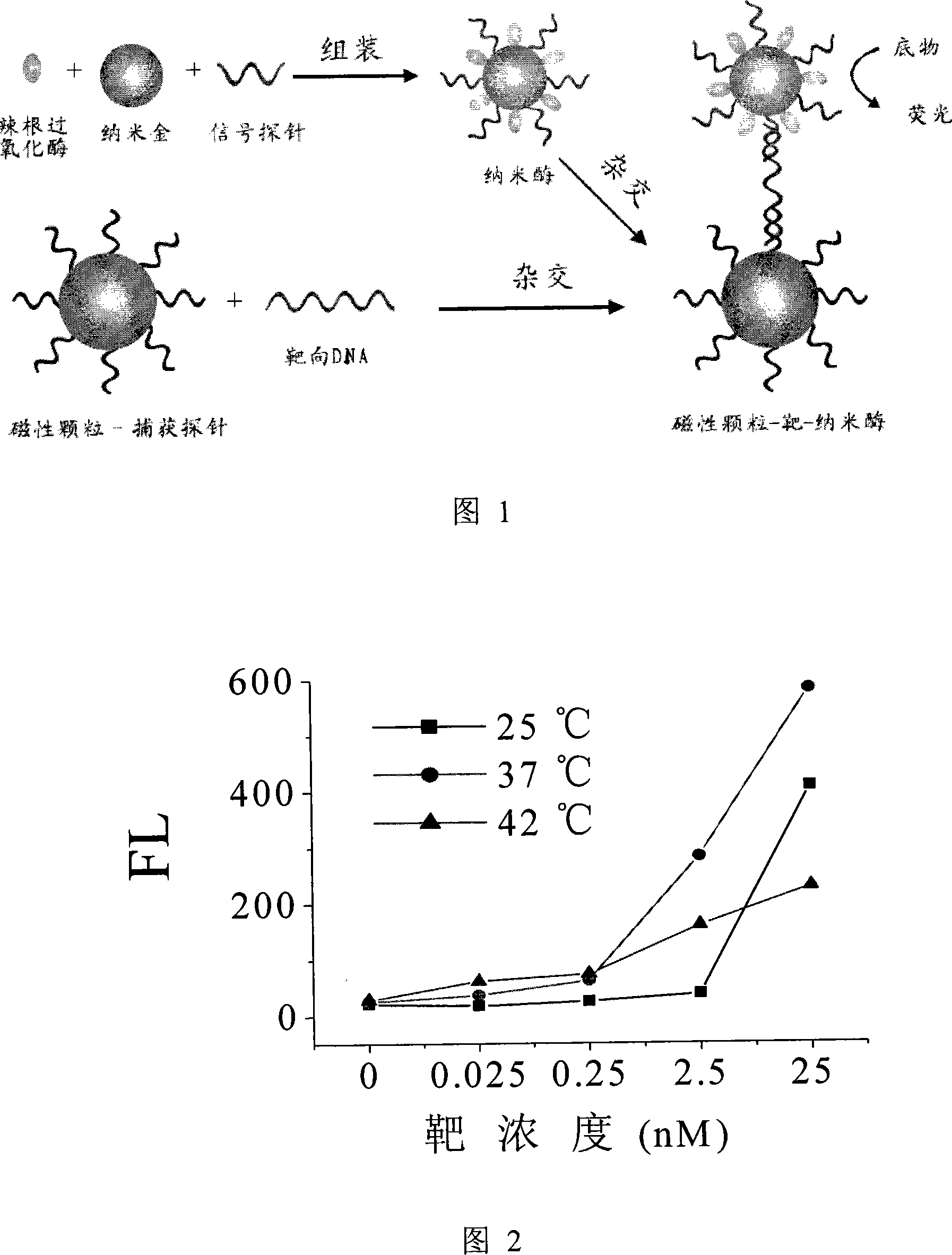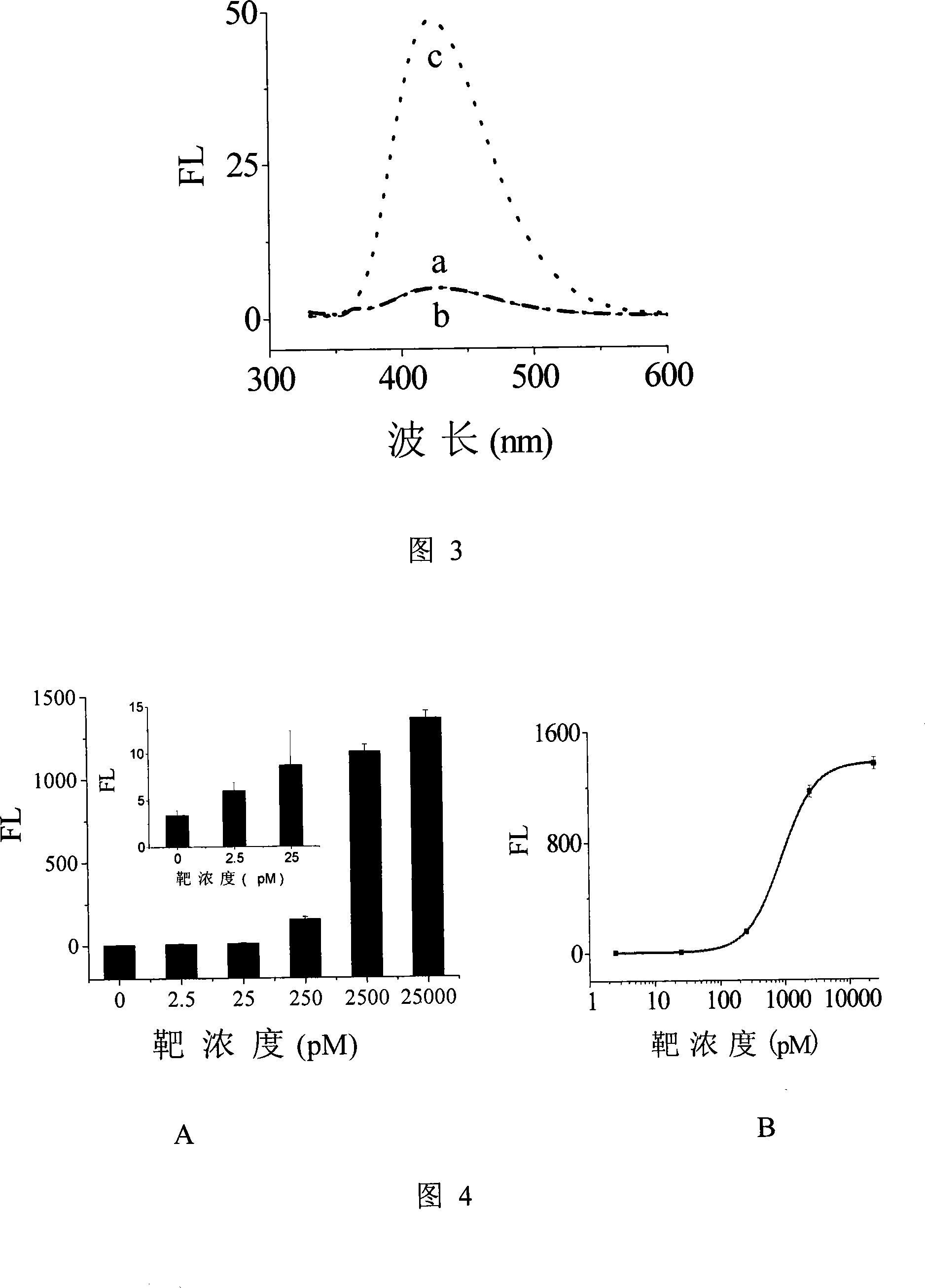Nano-gold signal probe for DNA detection, production method and method for detecting DNA
A signal probe and nano-gold technology, which is applied in the field of nano-gold signal probe and its preparation, and the DNA detection field of nano-gold signal probe, can solve the problems of increasing the steps of the reaction, and achieve high-sensitivity detection, convenient use, and preparation simple effect
- Summary
- Abstract
- Description
- Claims
- Application Information
AI Technical Summary
Problems solved by technology
Method used
Image
Examples
Embodiment 1
[0051] Example 1 Preparation of nanozymes
[0052] The method for preparing nanozyme 1 is: adding 100 μL concentration of 1% (w / v) HRP (purchased from Sigma company) solution into 5 mL nano-gold solution (HRP: nano-gold molar ratio is 1250: 1), with NaOH solution Adjust the pH to 9.0. This was followed by incubation at 37°C for 30 minutes with gentle shaking (350 rpm). Then it was concentrated to 1mL by centrifugation (13,000rpm, 30min, 4°C) (nano-gold concentration was about 10nM). Then add thiol-modified DNA2 solution (final concentration 1.5 μM, molar number of thiol-modified signal probe is 300 times that of gold nanoparticles), and incubate at room temperature for 16 hours. Then, a certain amount of 1M PBS was added gradually until the final concentration of NaCl was 0.1M, and left at room temperature overnight. Afterwards, 100 μL of 10% (w / v) BSA solution was added to block the vacant sites on the surface of the gold particles, and blocked at room temperature for 30 m...
Embodiment 2
[0057] Embodiment 2 The influence of reaction temperature of the present invention on target gene detection
[0058] According to the product instructions, MMPs were first washed 3 times with 0.5×SSC buffer before use, then biotin (biotin)-labeled capture probe DNA 1 was added to MMPs containing TTL buffer, and mixed gently for about 10 minutes . The surface density of capture probes is about 4-6×10 11 chain / cm 2 . Then the complex of MMPs and capture probe (MMPs-capture probe, denoted as MMPs-cp) was washed twice with TTA buffer, suspended in the hybridization solution, and refrigerated at 4°C for use.
[0059] Add 50 μL of MMPs-cp into a 1.5 mL centrifuge tube, discard the supernatant by magnetic separation, then add 1 mL of hybridization buffer, and at the same time add specific targeting DNA3 at a concentration between 0 and 25 nM. °C, 800 rpm, and react for 1 hour. Then add 50 μL nanozyme working solution, and react at 37°C for another 1 hour. Finally, magnetic sepa...
Embodiment 3
[0061] Embodiment 3 The present invention is to the specificity of DNA detection
[0062] The experiment was carried out with reference to the conditions in Example 2, the reaction temperature was 37° C., and the specificity of the detection method of the present invention for DNA detection was analyzed. Specific targeting sequence DNA3 at a concentration of 250pM and non-homologous sequence DNA4 at a concentration of 250nM were tested.
[0063] The result is shown in Figure 3. It can be seen that even non-homologous sequences at concentrations as high as 1000-fold can be significantly distinguished from specific targets, indicating the high specificity of the method.
PUM
 Login to View More
Login to View More Abstract
Description
Claims
Application Information
 Login to View More
Login to View More - R&D
- Intellectual Property
- Life Sciences
- Materials
- Tech Scout
- Unparalleled Data Quality
- Higher Quality Content
- 60% Fewer Hallucinations
Browse by: Latest US Patents, China's latest patents, Technical Efficacy Thesaurus, Application Domain, Technology Topic, Popular Technical Reports.
© 2025 PatSnap. All rights reserved.Legal|Privacy policy|Modern Slavery Act Transparency Statement|Sitemap|About US| Contact US: help@patsnap.com


